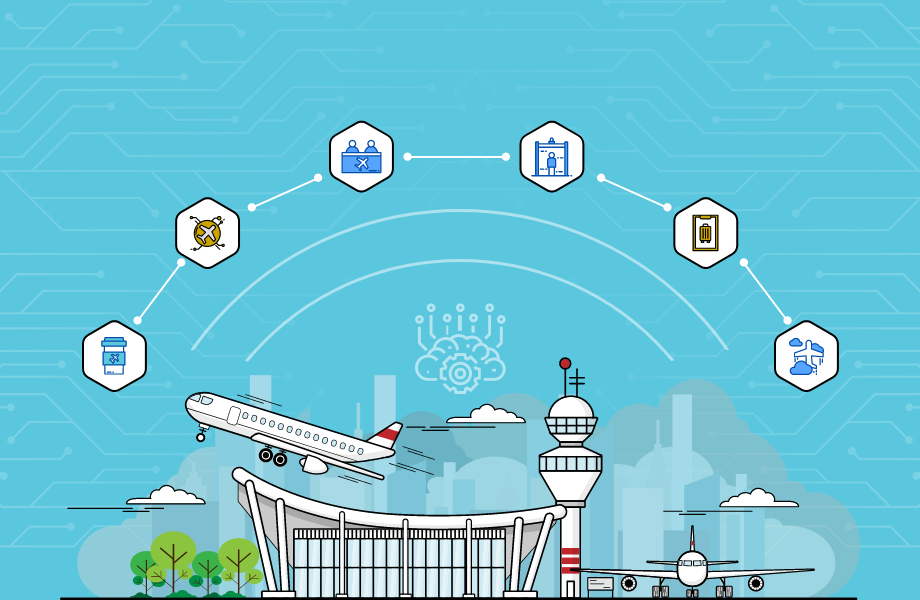
Artificial Intelligence is gaining momentum as we have defining examples across industries. In a travel itinerary, the airport plays a significant role. It is essential to build the airport to equip the expectations of the passengers. It helps every stakeholder associated with getting benefited. The best way to make the airports smarter could be – infusing Artificial Intelligence. AI may help us across the primary functions of the airport operation. But we will see how the AI can step-in to address the specific areas or challenges.
We can consider few areas like (1) Dynamic Flight Schedules (2) Airport Staff Optimisation (3) Airport Retail (4) Airport Safety (5) Airport Congestion (6) Airport Approach and Environment (7) Customer handling to name a few.

Dynamic Flight Schedules
Love to do a day passes – as planned. But sometimes it doesn’t happen. For airports, ‘Life is Lie’ for a few philosophical staff. Just because of the dynamic changes, particularly for ATC Staffs. Any flight diversions, Flight delays, or disruptions are genuinely challenging, especially during peak periods. AI can predict and assist the ATC, so the landing and take-offs are handled intelligently.
Airport Staff Optimisation
Handling the delay or disruptions, not only for ATC but for the airlines’ managers, also a tough call. AI can step in to help the Manager on Duty / Airport Managers of the airline to adjust the staff using AI Technology, especially where the skills of the service are essential. Deep learning can increase the accuracy of recommendation, and ML can assist in handling the equipments deployed successfully.
Airport Retail
Airports are now becoming profit centers. It is not a cost center anymore. The airport is now moving towards selling more goods than essential goods. It is a strategic location if planned it well, even for eCommerce units or brick-and-mortar companies. Deep learning and consuming the consumer profile within the data privacy limits can explore the abundance of opportunity for the airports. Airport apps can be built with AI capability so that It can guide the passenger to get the items that he would love to purchase.
Airport Safety
Video Analytics, coupled with AI components, can be a game-changer for Security officials of the airport. Movements of the erring passenger may be quick now. Security officials can be prepared well ahead of such an erring passenger based on the initial movement traction. Scanners of the baggages will get the next generation capability when you infuse more AI integrated repositories to identify and deduct illegal items.
Airport Congestion
Authorities can be alerted ahead of congestions on various parameters. Including the size of traffic expected, airline wise, % of diversions, anticipated delays, % of available infrastructure vs. congestion predicted can help the authorities to decide to supply provisions. What we need is the clarity of thinking and a collaborated approach with airlines and airports on sharing the data. Customs officials – headcount – can be optimized based on high and low volume prediction. Same the case with Security and ground staff. It gives excellent optimization apart form better planning. AI engines built with deep learning can assist.
Airport Approach and Environment
Like I mentioned, the collaborated data sharing on the passenger movement can even ease out the surface traffic pressures. So that the approach roads towards airports can be hassle-free. In case of congestion leading to such an approach, alternate routes are engaged. even if it is not available, one made based on these recommendations
Customer Handling
Customer handling, especially on simple queries, either unattended or not paid attention to having a big impact on the customer experience. Ideally, the customer desk should have more information on the airside as well as the city side. All the relevant data with possible queries that can be answered by AI bots is my answer.
Technology is an assistant. We need to use it appropriately with adequate Deep learning capability for the system to feed us with more accurate recommendations. So that the AI Engines can devise and chalk-out a plan for us to execute. See you soon on another blog. Thanks.